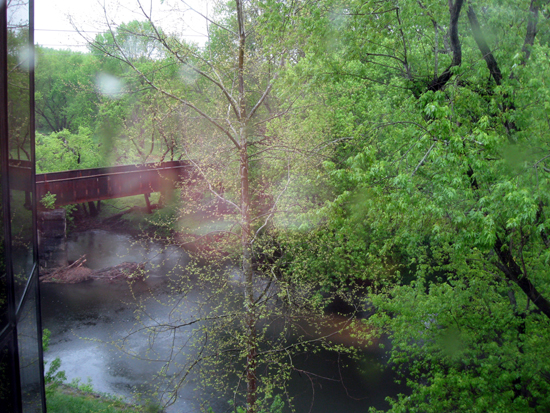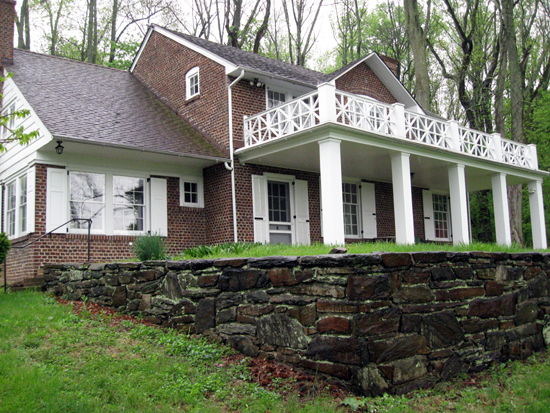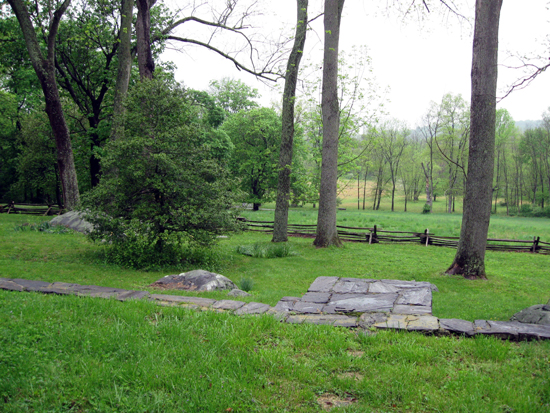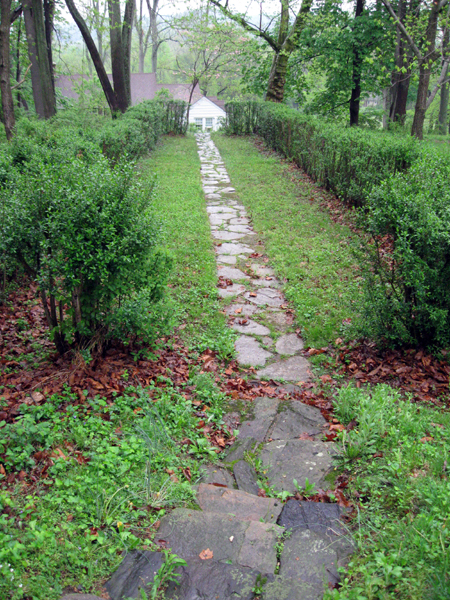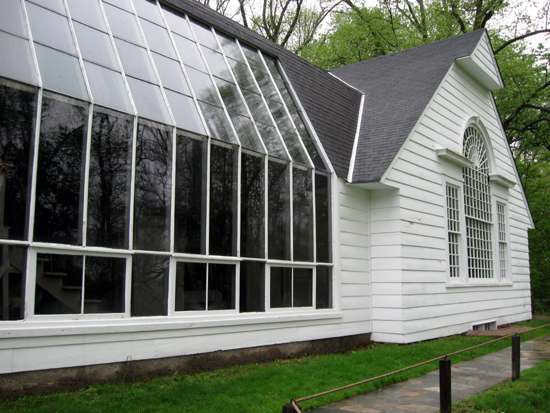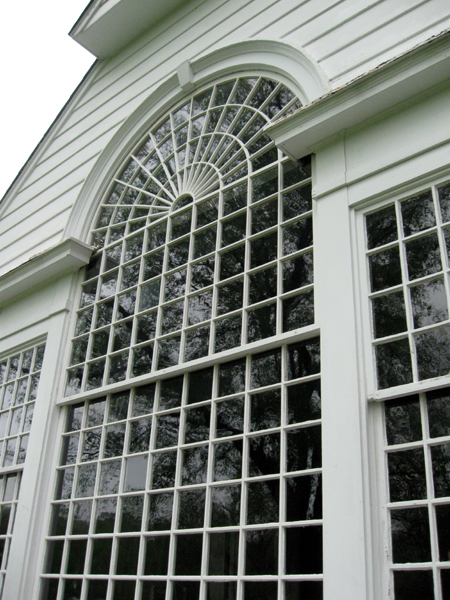But then I remembered that many of my Philadelphia friends
had been talking about the Edward Gorey exhibit, so we went directly
to the museum's site and found out the information. When we called Dad,
he was interested and knew where the museum was, so we agreed to just
meet there, rather than driving all the way to his hotel in Valley Forge.
The day was gray and rainy, and normally this would not
affect a museum visit. This particular museum also has a lot of gardens
and grounds, since it's located a stone's throw from the N.C. Wyeth
residence and in the same area that inspired all of Andrew's paintings.
The museum houses works by the Wyeth family, as well as many works of
art from illustrators, portrait artists and still life painters, all
of which relate to the Wyeth family's interests in painting.
Edward
Gorey, of course, is a 20th century artist and illustrator whose
darkly humorous black and white drawings are easily recognizable. Many
people know them from the opening animation sequence of Mystery
on PBS. He also illustrated a well-known edition of T.S. Elliot's Old
Possum's Book of Practical Cats.
I had always loved Edward Gorey's work, especially his dark takes on
nursery rhymes.
We started, of course, with the Gorey exhibit. There was, of course,
no photography allowed. The exhibition represented a sampler of his
work from throughout his life, including illustrations from his books
and even miscellaneous items, such as sketches, or envelopes he'd decorated
for letters to his mother in college.
The most fascinating aspect of seeing Gorey's work in person was noticing
how truly detailed they are. Looking at them, you can see the care that
he took to do them properly. I was also interested to see the places
where he made a mistake: where something was whited out, or where he'd
pasted a word or a portion of a drawing over something that he didn't
liked.
Much of this material I hadn't seen before, and it made me laugh out loud.
Other people were having similar reactions all over the museum. One of
my favorites was the frontispiece for his second collected works,
Amphigorey
Too. It features a woman in an evening dress, with an elaborate head
piece, sitting next to a dark swamp, holding a pair of galoshes. On the
edges of the design, standing or lying on a vine-like border, are four
men engaged in frivolous pursuits: flying a paper airplane, playing with
a yo-yo, playing with a ball-and-cup game, and juggling. Underneath them,
a banner reads, "Frivolity, at the edge of a Moral Swamp, hears Hymn
Singing in the Distance and dons the Galoshes of Despair."
I encourage you to click on this photo and view it at a larger size
so that you can see the detail.

I can't tell you exactly why that piece made me laugh
so hard, except that it's a perfect example of an intentionally heavy-handed
metaphor. A lot of his humor is like that: you laugh because there's
something wrong about it.
The exhibit also included a stuffed version of one of his creatures,
which was sort of a black, blobby humanoid with extra long arms. I found
myself wondering if he intended to give it to a child, and what sort
of reaction a child would have to such an odd toy.
You could get a sense for Gorey's sense of humor. I found myself wondering
how he could be at the same time so precise and so given to fancy. Then
again, I think it's people with the most ordered minds who find nonsense
so appealing.
One somewhat Gorean moment of the exhibit were these two older women
who didn't get most of the jokes. They would examine every drawing very
carefully, reading it out loud (a difficult feat, since many of his
drawings included French and nonsense words), sounding it out painfully,
syllable by syllable. Instead of grasping the joke within a few seconds,
like most of the guests, they seemed utterly baffled, and they would
engage in protracted discussions over why the drawing was supposed to
be funny. They never laughed, really, but they were very earnest about
trying to understand the jokes.
I was behind them for a while, but then I moved along, because it was
getting on my nerves. Near the end of the exhibit, I was near them again,
viewing some costume designs Gorey had done near the end of his life
for a production of Mikado. As they leaned in close to view the
last couple of drawings, one of them pronounced, "Well, they're
very hangable." The other agreed.
I laughed out loud, imagining them hanging one of Gorey's illustrations
in their home, never understanding the joke behind it. I also thought
immediately of what Gorey's artistic response would be to his work being
declared "hangable." I imagine it would be a self-portrait
in his
famous beaver coat, hanging from a gallows while two old ladies
held up a frame in front of him.
Then we visited the rest of the museum, starting with the N.C. Wyeth
gallery, which included his original illustrations for such books as
Treasure
Island. They were huge oil paintings. I'm not sure how the book
illustration process worked back then, but it was clearly different
from today's. I understand he would ship them to the publisher, who
would copy them using a process that was not explained.
The Brandywine River Museum has put together an excellent
online resource of the elder Wyeth's work, which includes details
on his paintings, if you'd like to see them for yourself.
Unlike the Gorey exhibit, there was more information available about
N.C. Wyeth's biography and career. Although he was primarily known for
his illustrations, he always wanted to be known simply as a painter.
His work is very dynamic, with a strong contrast lights and darks and
clear lines. His colors were vivid, which does not always come through
when they're reproduced.
We also got to see some of the weapons that he used as props in his
paintings. He collected antique firearms just for that purpose, and
they were never used. A rotating display of portions of his collection
is part of the gallery.
His most interesting painting that was not an illustration was based on
a dream he'd had, and it's called "In a Dream I Meet General Washington"
(just type "dream" into the search window at the above-mentioned
online resource to see it). He'd been working on a mural of George Washington
and had dreamt that Washington came alive and started narrating the battle.
The painting shows him on a ladder, while George Washington leans out
of the painting and talks to him, with a battle taking place in the background.
The original, unlike the reproduction, has luminous colors, with pastel,
dreamlike hills.
N.C. Wyeth painted every day, and he did quite a few still lifes (the
way that musicians play scales), some of which were on display.
Also on the same floor was a gallery of American painters of portraits
and still lifes. Many of them were from the Philadelphia area. We were
particularly impressed with the hyper-realistic paintings of George
Cope. He was best known for his "trompe l'oeil" paintings,
which to translate the French literally, fool the eye. Again, it's hard
to tell from the reproductions, but standing in front of the paintings,
they looked so real you thought that you could grab the objects. Talk
about a painstaking attention to detail!
Another floor featured paintings by Andrew Wyeth (official
Web site; Wikipedia
article), which are very different from his father's. He did not
study formally with him, although he was a frequent visitor to his father's
studio as a boy.
Andrew Wyeth is known for his tempura paintings, which uses tinted
egg to produce very natural, almost ethereal colors. For his entire
life, he set his paintings in the world around him, painting his neighbors
and the scenery around him. Unlike a typical landscape artist, he didn't
produce paintings of rolling fields and luminous sunsets, or an idealized
farmhand loading hay. Instead, he made the ordinary beautiful: whether
it was a broken-down pig pen or an elderly woman raking leaves in early-morning
light.
Paintings of such supposedly simple subjects can be much more complex
than you might realize, and I was interested to see just how much detail
was evident in these deceptively simple works. Unlike his father's thick
layers of paint, Andrew Wyeth's work seems delicate, ephemeral, almost
Impressionistic. His work, compared to his father's, is like a haiku
compared to a Shakespearean sonnet.
I enjoyed reading the information posted next to the paintings, since
it often included Wyeth's own words about those paintings, taken from
interviews or his writings.
On the same floor, as I remember, was a
gallery that included other paintings by members of the extended
Wyeth family. Of particular interest were those by Andrew's
son Jamie, who actually studied with his aunt, Carolyn, a skilled
portrait artist. He's particularly interested in the stage and in dance,
and painted some well-known portraits of the ballet dancer Rudolf Nureyev.
There are also some paintings by Peter Hurd, who married Andrew's sister,
Henriette.
In a gallery on the ground floor we viewed the exhibit on American
illustration. It even had a few Maxfield Parish frontispieces, which
were very intricate, although not as instantly recognizable as his larger
paintings.
Then, since we had time, we got some lunch in the cafeteria and purchased
tickets for the tour of NC
Wyeth's residence and studio.
By this point, the rain was really coming down, so I wasn't sure whether
I would buy the exhibition book on the Gorey exhibit. Turns out it is
available through the museum's online
catalog, although the person at the register didn't know whether
or not it was. As it turned out, though, I did have time after the tour
to purchase it.
We bought tickets and rode a little mini bus up to the house, both
of which were built by NC Wyeth with money earned from the Treasure
Island illustrations. Yes, illustrators were paid handsomely in
those days! Our fellow passengers were enjoying themselves despite the
rain, making small talk and cracking jokes.
Again, pictures were not allowed inside the buildings, but I got some
good photos outside. I would have gotten some with The Gryphon and Dad
in them, but it seemed a bit cruel to make them stand in the rain.
The house was a simple brick building, never owned by
anyone outside the Wyeth family. After N.C. and his wife passed away,
daughter Carolyn lived there until her death until 1996. All of the
furnishings are original to the family, including a grand piano, some
sitting-room couches in the large room where the family would gather,
and a special dining-room table designed by NC to fit inside their narrow,
wood-paneled dining room.
There are also a few portraits of family members from several generations
on the walls. As the tour guide explained, the Wyeth family did not
like photographs but preferred paintings.
Despite living in the 20th century — he died an accident at a
railroad crossing in 1945 — N.C. Wyeth did not cotton to modern
appliances. The family read books and played the piano for entertainment.
Of course, Carolyn might have acquired some more modern items during
her long life, but they were not on display.
Then we got back in the bus and rode up to the studio, which N.C. Wyeth
had built on the top of the hill to get more light. His studio featured
large windows on the north side, which is ideal for letting in the most
natural light during the day. Even though it was a gray day, even without
any electronic lights, the studio was fairly well-lit inside.
Every day, he'd take his daily "commute": walking the flagstone
path up to his studio from the house.
I have seen photos of other artists' studios, and they
always look like such fabulous places to hang out: filled with items
of inspiration along with crafts of the trade. N.C. Wyeth had a foyer
that included a large box filled with costumes, which the children were
allowed to use for games of make-believe. A shelf was filled with bound
collections of the magazines that carried his illustrations, while another
rack contained prop guns.
The original studio, with its large plate glass window, had an easel,
cigar boxes full of paints, and containers of brushes. But it also had
neatly organized stacks of National Geographics, Greek busts,
a fantastic model ship, rounded green glass bottles, and even a stuffed
river otter!
A lower level, built later, was used to paint large murals. He could
hang them on a wall and use a specially-built rolling ladder to access
whatever portion he was painting. Paintings by N.C. Wyeth were actually
on display, as if he'd just finished them.
I can imagine what it must have been like for the Wyeth children, visiting
their dad whenever he was at work, playing with the props, smelling
the paint, and looking out the window at the green vistas. No wonder
so many of them took to art.
As we left, I thought about how Wyeth's studio contrasts with my own
office, a cramped room that also serves as a guest room. My best intentions
of organization, born in January, have since lain fallow, and it contains
stacks of papers and books, threatening to spill over, causing me to
infrequently cull them. A collapsible tray table sits next to my desk
(itself an ill-designed creation from Fingerhut, with a middle shelf
that allows for storage but is inconvenient for anyone with knees).
On a nearby shelving unit, boxes from IKEA contain old computer disks,
folders, envelopes, and miscellany. The opposite walk hjas two book
shelves stacked on top of each other: one containing reference books,
poetry books, and books to review for Wild
Violet; the other being my "books to read" shelf,
which is currently spilling over. A few works of art hang on the wall:
a pastel of my dog Una, done by my Mom; a young woman patting a stuffed
bunny, which was left behind, with no artist info, at an Otakon art
auction; a collage my sister did for me that includes photos of women
from all over the world.And of course, against the wall to the left
of my desk, sitting on top of a plastic rolling shelf in which I keep
office supplies, the small TV where I watch American Idol and
other shows. (I'm such a multi-tasker.)
Since my window looks out only on the houses across the alley, I always
keep the blinds closed, with just a couple inches of space to let the
light in. No wonder I often walk my dog to get inspired!
When we get a bigger place, I'd like to have an office that's more
like an art studio, with items of inspiration on display. A view would
be nice, too.
